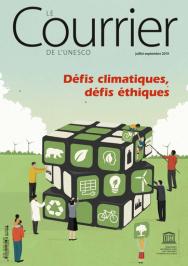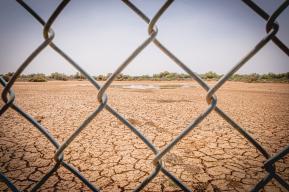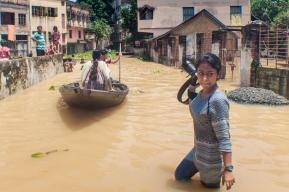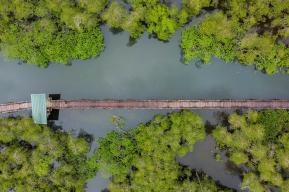مقال
الطاقة الشمسيّة تغيّر الحياة في أرياف كينيا

غيّرت المضخّات والمصابيح الشمسية الحياة اليوميّة للتجمّعات الريفية في كينيا بفضل توفير المياه الصالحة للشراب، والإضاءة، وتخليصها من عبء الأعمال الشاقّة، والأمراض والممارسات الضارّة بالمناخ. وقد ساهمت الإرادة الحكومية في الاستثمار في الطاقة النظيفة التي حظيت بمساندة القطاع الخاص، في تحسين جودة ظروف العيش بشكل ملموس، خاصة لدى أكثر السكان فقرا.
بقلم فيكتور بوير
في نيانديوا، بمقاطعة هوما باي، لم تجد جاين أكينيي سوى هذه الكلمات البسيطة للتعبير عن مشاعرها: «ليس لي أن أقول غير أني أشكر الله الذي تذكّرنا، وأشكر الذين عملوا على إنجاز هذا المشروع». فرغم أن قريتها تقع على مقربة من بحيرة فيكتوريا التي تعد من أكبر مخازن المياه العذبة في العالم، كانت محرومة من الماء الصالح للشراب منذ عقود.
وتُضيف: «كان على النساء قطع الكيلومترات للوصول إلى الأنهار، وكانت الطوابير اللامتناهية أمام منابع الماء النادرة في المنطقة تُجبرنا على قضاء كامل اليوم هناك، و بالتالي تؤجل المهامّ المنزلية الأخرى، ممّا يؤدي إلى خلق مزيدا من المشاكل».
ولما انطلق حديثا تشغيل خمس مضخّات بالطاقة الشمسية، أصبحت تلك المِحن في عداد الماضي. هذا البرنامج الجديد الذي يستفيد منه حاليّا أهالي 700 بيت في سبع قرى، والذي بُعث في 11 فبراير 2019، يوفر لهم الماء الصالح للشراب والطبخ، وفي ذات الوقت يؤمن حماية حوض تجميع مياه نهريْ رنغوي وريانا. في نيانديوا، تبلغ كميّة التدفق 3000 لتر في الساعة، بفضل تعزيز المضخّة التي تتطلب 2،2 كيلوات بلوحات شمسية ذات 5 كيلوات مما يتيح تشغيلها حتى عندما يكون إشعاع الشمس ضعيف.
في الماضي، كان سُكان دائرة رنغواي مُجبرين على تغلية الماء لتفادي الأمراض المائية مثل الكوليرا، خاصّة منذ انقطاع الأنابيب وتلوّث الماء النظيف بالماء الخام. إلّا أن تغلية الماء تتطلّب الحطب. وبسبب نفاذ التموين، اضطر السكان للتزود من حوض تجمع الأنهار. فاقتضى الأمر تدخل الصليب الأحمر الكيني ونائب الدائرة لإحياء مشروع قديم لتوفير الماء الصالح للشراب بواسطة مضخّات بوقود الديزل، وهو مشروع يعود إلى سنة 1979 وتمّ تركه منذ ذلك الحين.
وتمثّل عمل الصليب الأحمر الكيني الذي يُسيّر المشروع، في تسييج المنبع القديم قصد حمايته، وتصميم خزّان وبنائه، ووضع مضخات مزودة بالطاقة الشمسية. إن ترك العمل بالديزل وتعويضه بالطاقة الشمسية مكّن السكان ليس فحسب من ادّخار ثمن المواد البترولية الباهض، وإنما أمّن لهم أيضا تزودا ثابتا، مع تلافي تلوّث الهواء جرّاء استعمال الديزل.
بالنسبة للقطاع الخاص، مثّلت الطاقة الشمسية فرصة لتنمية التجارة، بالإضافة إلى توفير طاقة تضمن سلامة المناخ للمجتمعات المحرومة. وقد دعم هذا القطاع (الشركات التجارية والمنظمات غير الربحية على حد السواء) الاستثمارات الحكومية، فكان له دور أساسي في ازدهار الطاقة الشمسية التي تطوّرت بقدر كبير في كامل أنحاء البلاد بفضل العديد من المبادرات – أسعار مُدعّمة بنسبة عالية، الترويج على الصعيد الاجتماعي وبرامج لتيسير الحصول على القروض المالية.
التركيز على الشبكات النسائية
على سبيل المثال، توفر شركة سوليبريوم المحلّية الطاقة الشمسية بأسعار في متناول الجميع. هذه الشركة هي فرع من إيكو2ليبريوم المصنفة «بينيفيت كوربورايشن» [شكل جديد من الشركات يحقق التوازن بين المفعول الإيجابي والمرابيح]، تقع مكاتبها في الولايات المتحدة وفي كينيا. تُسوّق سوليبريوم لوحات، ومُعدّات ومصابيح شمسية عن طريق مجموعات النساء، بواسطة قروض أو نظام أسعار مُدعّمة. وتقبل الدفع على عدّة أقساط بعد التركيب، مع حوافز لمن يدفع بالحاضر. وحتى توسع دائرة الحرفاء، تمنح لبعض المُستعملين صفة مُمثّلين تجاريين.
قامت سوليبريوم بتشغيل حوالي 200 امرأة عبر حركة المجموعات النسائية، أسندت لهنّ مهمة الترويج النّشِط للمنتوجات الشمسية في ست مقاطعات كينية. وقد حققت الشركة لحد الآن تجهيز أكثر من 50.000 منزل.
لقد غيّرت المصابيح الشمسية حياة السكان. ويُؤكّد أنطون إسبيرا، مؤسس الشركة ومدير الاستثمار فيها أن «التجهيزات الشمسية خفّضت من الآثار الناتجة عن استعمال محركات الديزل - بالخصوص في ما يتعلق بتشغيل مضخّات المياه والمستشفيات - على صحة السكان وتلوّث الهواء. لقد خلّصتنا المصابيح الشمسية من الكيروسين الذي كان مؤذيا للبصر، علاوة عن كونه باهِض الثمن. كما تمّ الحد من تدمير الغابات بما أنه لم تعد هناك حاجة لفحم الحطب. وقد أتاح الحصول على الطاقة للأطفال مراجعة دروسهم ليلا»
في صالح صغار مالكي الأراضي
ويعتبر جون أوهاغا، من وان آكر فاوند وهي منظمة دولية ذات أهداف غير ربحية متواجدة في أفريقيا الشرقية، أن الطاقة الشمسية، عبر المصابيح وآلات الشحن مثلا، لها دور هام في تمكين التجمّعات الفلاحية على المستوى الاقتصادي، مُوضّحا أن «تلك الفوانيس تسمح لبعض الفلاحين بالعمل إلى ساعة مُتأخّرة مساء، ممّا يتيح لهم العمل أكثر. وتوفر لهم إمكانية إعادة شحن هواتفهم المحمولة حتى يستعملوا بالكامل منصات الدفع الإلكترونية، كما تمكنهم من استخدام المصابيح لمواصلة أشغالهم الفلاحية ليلا».
كما يلجأ هؤلاء الفلاحون أكثر فأكثر إلى النظم الشمسية للريّ سدا لتقلبات الفصول التي يعسر التنبّؤ بها بالنظر إلى خصوصية المناخ الكيني. في الماضي، كانت الزراعات السقوية حكرا على كبار المزارعين مما يضمن لهم إنتاجا ثابتا، واليوم تحسّنت ظروف صغار الفلاحين الفقراء بعد أن كانوا غير قادرين على الاستثمار في زراعتهم وفي أرضهم. بالإضافة إلى ما يضمن لهم الحصاد الأوفر من أمن غذائي.
تحسين استعمال الطاقة الشمسية
حسب تقديرات الوكالة الدولية للطاقة، سوف تشكل الطاقة الشمسية الضوئية في موفى سنة 2040 الجزء الأكبر (47%) من التكنولوجيات المُنتجة للطاقة بواسطة الشبكات الصغيرة والنُظم خارج الشبكات في جنوب الصحراء الأفريقية. وحسب دراسة أصدرها سنة 2016 معهد الموارد العالمية، حققت م-كوبا سولار، وهي مؤسسة كينية مختصّة في المواد الشمسية، وضع 225.000 تجهيز شمسي عبر البلاد.
التزمت كينيا بتخفيض انبعاثاتها لثاني أكسيد الكربون بنسبة 30% في أفق 2030. وبما أن النُّظم التي تعتمد على الطاقة الشمسية تقلل من استعمال الآلات ذات المحركات المشتغلة بالديزل أو بالبنزين، وتخفف من استغلال الغابات للحصول على فحم الحطب، اكتسبت تلك النظم فعالية أساسية لا فقط قي الحد من المشاكل التي تعترض النساء والأطفال في المناطق الريفية، وإنما أيضا للحد من تأثيرات تغيّر المناخ على نطاق كامل البلاد.
تعتمد الإجراءات الرامية لمقاومة تغيّر المناخ على القرارات الحكومية طبقا للاستراتيجية الوطنية لمقاومة تغيّر المناخ 2010 ومخطط العمل الوطني للتصدي لتغيّر المناخ 2013. كما يتم حاليّا العمل على اعتماد سياسة وتشريع على المستوى الوطني لتدعيم جدواها. وقد أعدّت الحكومة الكينية أيضا لائحة تنظيمية لقطاع الطاقة (يُغطّي الطاقة الشمسية الضوئيّة)، يُجبر العاملين في القطاع على أن يكونوا مُسجّلين وحاصلين على رُخص.
وجاء في الخطّة الحكومية التوجيهية حول قطاع الطاقة أن كينيا التي تقع على الخط الاستوائي، تتمتع بموارد شمسية هائلة تجعلها في هذا المجال من بين البلدان العشرة الأولى جنوب الصحراء الأفريقية. وبالنظر إلى صعوبة الحصول على موارد الطاقة التقليدية وإلى مستوى الفقر في كينيا، تحظى الطاقة الشمسية بإمكانيات وفيرة. وتعتزم الحكومة، بالاعتماد على إطارها القانوني في مجال الطاقة، على استغلالها على الوجه الأمثل. ومن المُتوقّع أن يتطور استهلاك الكهرباء على المدى المُتوسّط بمعدّل 7،2% سنويا، وأن يبلغ نسبة 140% في عام 2020 بالمقارنة مع عام 2015. فمن الضروري إذن إيجاد حلول مُتجدّدة، لصالح المجموعات المُهمّشة وصغار المستهلكين.
اطلع على مقال حتى يعمّ النور كل أرجاء العالم! المنشور في رسالة اليونسكو بتاريخ أبريل-مايو 2019.
By Victor Bwire
“I have nothing more to say than thank God for remembering us, and the people who have made the completion of this water project here possible” Jane Akinyi, a resident of Nyandiwa in Homa Bay county says. Even though the area is not far from Lake Victoria, one of the largest fresh-water lakes in the world, access to clean drinking water has remained unattainable here for decades.
“Women used to walk several kilometres to the rivers to seek water, and often, the long queues at the only water points in the region would mean you could waste the whole day waiting. This meant chores at home would remain undone, resulting in other challenges,” Akinyi explains.
The recent commissioning of five solar-powered water pumps in the region has made these hardships a thing of the past. Currently serving 700 households in seven villages, the new water project, launched on 11 February 2019, gives residents access to clean water for drinking and cooking, while protecting the water catchment areas around the Rangwe and Riana rivers. Its water pump at Nyandiwa produces 3,000 litres of water per hour – the 2.2 kilowatt pump has been reinforced by a five kilowatt solar structure, to ensure that it works even when sunshine levels are low.
Previously, the people of Rangwe constituency were forced to boil their water to avoid contracting waterborne diseases such as cholera. This was especially important after water pipes burst and clean water was contaminated by raw water. Boiling water requires firewood and the burst pipes meant that people had to fetch water from the catchment areas – both these actions contribute to climate change. It took the intervention of the Kenya Red Cross Society (KRCS) and the area’s Member of Parliament to rehabilitate an old water supply project that was conceptualized in 1979 to run using diesel power, but was never completed.
Eliminating pollution
The work involved the KRCS – which manages the new project – undertaking the fresh protection of the old water spring and fencing it, designing and constructing a new sump tank, and installing solar energy-based pumps. The use of solar energy, instead of diesel, to pump the water has not only saved the community from the high costs associated with using petroleum products, but has also ensured a steady supply of clean power – all without adding any air pollution.
The private sector has viewed solar energy as a business opportunity, while providing climate- friendly energy to poor communities. In addition to government investment in the development of solar energy in the country, the private sector – both businesses and non-profits – have been instrumental in the growth of the sector. Through such initiatives as highly subsidized prices, social marketing and loan schemes, a number of entities have aggressively expanded the use of solar systems across the country.
Targeting women’s networks
Solibrium, a local company, provides solar power at affordable prices. It sells solar panels, solar systems and solar lamps to communities through women’s groups, offering loans or a subsidized price system. Residents have access to the solar systems and can pay in installments. Incentives are extended to those who pay promptly and some existing users are made sales representatives to recruit more users.
Solibrium has recruited nearly 200 members through women's communities, who actively promote the sales of solar products in six counties in Kenya. More than 50,000 households have been equipped by the company so far.
The solar lamps have been life-changing for the communities. “The solar systems have reduced the health burden and air pollution related to using diesel engines within the communities. For example, for generators at water pumps and hospitals, the solar lanterns have eliminated the use of kerosene, which was not only expensive, but caused eyesight problems for users. It has reduced the destruction of forests by eliminating the need for charcoal, and the availability of power also enables children to do their homework after nightfall, without hurdles,” Anton Espira, the company’s founder and chief of operations explains.
Benefiting small landowners
The solar systems, which include lamps and chargers, play a significant role in the economic empowerment of the farmer communities they are working in, affirms John Ohaga of One Acre Fund, an international non-profit working in East Africa. “These lanterns have helped some of the farmers do business late into the night, thus growing their businesses. They are able to charge their phones, thus fully utilizing the online payment platforms, and use the torches to continue some work on the farms after dark,” he says.
Farmers are also increasingly using solar irrigation systems to deal with the unpredictable seasons brought about by Kenya’s climate. Unlike before, when irrigation farming and predictable farm produce was mainly associated with the rich who could afford them, things have changed for the better for these formerly poor farmers, who were unable to invest in their crops and land. A better harvest also means food security for these farmers.
Optimizing solar energy
According to estimates by the International Energy Agency (IEA), solar photovoltaic energy will contribute the largest share (forty-seven per cent) of the technology mix for mini-grids and off-the-grid systems power generation in Sub-Saharan Africa by 2040. M-KOPA Solar, a privately-held Kenyan solar energy company has installed 225,000 solar energy products in the country so far, a 2016 study by the World Resources Institute indicated.
Kenya has committed to reducing its carbon dioxide emissions by 30 per cent by 2030. Decreasing the use of diesel and petrol machines and easing pressure on forests by using less charcoal, the solar power systems are a major intervention that not only alleviate the problems faced by women and children in communities, but also play a big role in mitigating the adverse effects of climate change in Kenya.
The climate change interventions in Kenya are guided by governmental decisions as reflected in the National Climate Change Response Strategy (NCCRS 2010) and the National Climate Change Action Plan (NCCAP 2013). Meanwhile, a National Climate Change Framework Policy and legislation are in their final stages of enactment to facilitate an effective response to climate change. In addition, the Government of Kenya has developed Energy (Solar Photovoltaic Systems) Regulations, which require the registration and licensing of players in the sector.
The Government Master Plan for the energy sector notes that due to its position on the equator, Kenya is endowed with very high solar resources, among the highest ten of Sub-Saharan African countries. Given the challenges posed by conventional energy sources and poverty levels in Kenya, solar energy has high potential – the government, through its energy regulatory framework, is working to ensure the maximizing of this resource. Electricity consumption is forecast to grow in the medium term by an annual average of 7.2 per cent per year, a 140 per cent increase over the 2015 level, by 2020. This makes it imperative to find renewable energy solutions to benefit marginalized groups and small-scale users.
Victor Bwire
Head of Media Development and Strategy at the Media Council of Kenya, Victor Bwire is an environmental journalist. He also trains journalists on environment, health and related issues.











